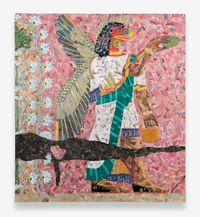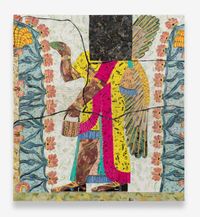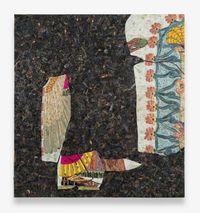


Barakat Contemporary cordially invites you to Michael Rakowitz's first solo exhibition in Korea: The invisible enemy should not exist (Northwest Palace of Kalhu, Room F, Southeast Entrance; Room S, Southwest Entrance) from May 10 to July 30, 2023.
The exhibition presents key works that Michael Rakowitz has been dedicated to for more than 20 years since the 2003 US-led invasion of Iraq. Rakowitz has been continuously reappearing and returning the lost cultural heritage of Iraq in both autobiographical and historical registers: Rakowitz's own family history of from Iraq to the US due to their Jewish faith, and Mesopotamian relics that were destroyed or have gone missing in the aftermath of the War. From humble food packaging to ancient Assyrian stone reliefs, Rakowitz listens to the stories of all the objects that have disappeared along with the humans displaced by force and puts forth practical methods of healing from the trauma rendered invisible.
The invisible enemy should not exist (Northwest Palace of Kalhu, Room F, Southeast Entrance; Room S, Southwest Entrance) is the title of the exhibition as well as the premiering installation that stretches across the first floor. 'The invisible enemy should not exist' is the translation of Aj-ibur-shapu, the name of the Processional Way into the city of Babylon past the Ishtar Gate, built circa BCE 575 under King Nebuchadnezzar II.
Entrance; Room S, Southwest Entrance)_ (2023)
The invisible enemy should not exist (Northwest Palace of Kalhu) (2018–ongoing) is a chapter of The invisible enemy should not exist (2007–ongoing), which reappears the artifacts in the National Museum of Iraq looted after the Iraq War broke out. The invisible enemy should not exist (Northwest Palace of Kalhu) reappears the Northwest Palace of Kalhu (current-day Nimrud, Iraq) commissioned by Neo-Assyrian King Ashurnasirpal II (883–859 BCE) was devastated by ISIS or Daesh in 2015.
The invisible enemy should not exist (Northwest Palace of Kalhu, Room F, Southeast Entrance; Room S, Southwest Entrance) instructs the exact locations of the Palace that the artist with his studio team has reappeared: the five stonecarved panels that used to line the right wall and the southeast entrance of Room S, and two panels on each side of the southwest entrance of Room F. Rooms S and F are the main entrances to the courtyard in the center of the Palace, used to host esteemed guests. Using Arabic-English newspapers and Middle Eastern food packaging readily found in Chicago, the panels and their once brilliantly painted surface are reconstructed in papier-mâché technique. The reliefs depict apkallu, the winged demi-gods either human or bird-headed, surrounded by the sacred trees and the 'Standard Inscription' running across the center of each panel unit. The installation of the panels corresponds to the original architectural footprint, with missing pieces of the original panels and spaces marked with labels indicating the archaeological displacement or looting already in situ before the destruction by ISIS. The labels note that most of the missing pieces are in the collection of Western institutions, and the extractions of these artifacts had already, in fact, begun much earlier.
Michael Rakowitz's representative video work, The Ballad of Special Ops Cody (2017) is a stop-motion film portraying Cody, a GI action figure sympathizing with the Mesopotamian votive sculptures displayed at the Oriental Institute, University of Chicago. Cody offers the Mesopotamian votive statues locked in vitrines an accomplice in escape. Cody receives a silent, petrified stare as an answer, and eventually, he meekly stations next to the Sumerian figurines, encased.
Special Ops Cody made a media appearance in 2005 when it was revealed that the photo of a US soldier named 'John Adam' held hostage by the Mujahideen group in Iraq was in fact, the photo of Cody. Only sold at the American military bases in Iraq and Kuwait, Cody was often sent to the children back in the US as a surrogate for their soldier fathers who could not promise the exact return date. Similarly, the votive statues of Sumeria were surrogates of worshipers in the wish to extend their devotion and faith. And through the voice-over of Cody by retired Sergeant Gin McGill-Prather who was deployed to Iraq in 2004, Cody becomes another proxy in bridging the gap between the ancient and present, object and real human experience. In the oddly similar circumstance that both Cody and the relics are put in, Rakowitz draws out the manifold identities and provenance displaced by political contexts. Furthermore, through McGillPrather's description of her own experience in the War, The Ballad of Special Ops Cody explicates the ambivalence in which US soldiers as individuals may also be victims rather than perpetrators.
Video installation RETURN (2004–ongoing), presented on the second floor of the gallery, diverts the unspoken repression of Iraq through the artist's own autobiographical heritage. Born in Great Neck, New York, Michael Rakowitz grew up in his maternal grandparents' house surrounded by the most intricate 'installation art': a total assemblage of things, music, and food from Iraq that filled the young artist's senses with the idea of the country. His grandfather, Nissim Isaac David (1899–1975), an Iraqi Jew, fled from Iraq with his family in 1946 to escape the suppression inflamed by Iraqi nationalists with Nazi Germany and eventually settled in Long Island, US. Although Michael Rakowitz has never been to Iraq and perhaps never will, the longing coupled with the vivid memories handed down to him possibly allowed more space to construct an evocative concept of home, piece by piece.
After settling in the US, his grandfather resumed his import and export company, Davisons & Co., a very successful trading company in the Middle East, and operated it until the 1960s. In 2004, Michael Rakowitz reopened the business as a part of the project RETURN (2004–ongoing), initially in the form of a drop box, and then slowly expanding it as a center that provides free shipping for items sent to Iraq. In 2006, it was officially launched as a storefront at 529 Atlantic Avenue, Brooklyn. Here, Rakowitz launched what seemed to be an impossible business. After running into a can of Iraqi dates labeled as a product of Lebanon despite the UN sanctions against Iraq (1990–2003) being lifted, he was determined to import the Iraqi dates into the US. The video component of RETURN documents the entire longwinded process, from the bureaucratic handling to ardent debates at numerous immigration checkpoints.
The timeline of RETURN denotes a record of dates dating back to 50,000 years ago in Iraq, ranging to its significance to the recent socioeconomic activities of the Iraqi people as the second largest export after oil. Spanning long stretches of time as both an emblem and part of everyday life, the dates themselves have become an intermediary or a 'drop box,' through which many Iraqi people's lives were shared and nurtured. And when the wars broke out consecutively and those very lives were wounded and killed, so did the dates.
Within a month after the US-led coalition invaded Iraq, the looting of the National Museum of Iraq began. Michael Rakowitz's ongoing effort The invisible enemy should not exist to reappear these stolen artifacts, unfortunately, evolved—including his initiation of conversations about restitution and repatriation with Western institutions—as the calamities continued. As The invisible enemy should not exist (Northwest Palace of Kalhu) implicates, artifacts and their origins that gave pertinent agencies to the individuals living alongside them were upheaved by imperial excavations to wars. Their original form or context can never be reconstructed.
This year marks the 20th anniversary of the 2003 Iraq War. And unfortunately, the continuous displacement of peoples and cultural heritage is not unique to Iraq. How do you move forward without denying the past? Like the scope of time laid out in RETURN— from 50,000 BC and his grandparents' generation to the present—Rakowitz looks at the objects that lived alongside people, what looks like the peoples themselves, and brings them to the current as not from an archaeological perspective, but to circle it back to the people who were also separated from their homes and legacies. Michael Rakowitz with his studio gave them the shells and skins commonly accessible from everyday life, and the brilliant colours like the blood is flowing through the veins again. Rakowitz has been calling this 'haunting the West,' not restoration. Between the physical displacement and amnesia, it is through the memories, the ideas of them accompanied by the immediate context of material culture that they manifest once again, and they are back to haunt. And they are haunting because they were taken away by force, and Rakowitz brings them back to resuscitate what was otherwise imperceptible.
Press release courtesy Barakat Contemporary.
58-4, Samcheong-ro
Jongno-gu
Seoul, 03053
South Korea
www.barakatcontemporary.com
+82 02 730 1948
Tuesday – Sunday
10am – 6pm
Closed on Mondays and National Holidays